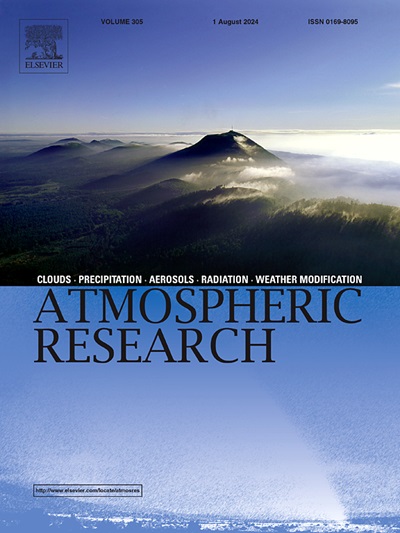Extreme wildfires over northern Greece during summer 2023 – Part A: Effects on aerosol optical properties and solar UV radiation
IF 4.5
2区 地球科学
Q1 METEOROLOGY & ATMOSPHERIC SCIENCES
引用次数: 0
Abstract
In Mediterranean countries, such as Greece, the frequency of forest fires has increased in recent years, primarily due to the widespread impacts of climate change. At the end of August 2023, Greece experienced a record-breaking heatwave that triggered severe wildfire incidents, significantly impacting the atmospheric conditions of several cities, among them Thessaloniki. A significant number of wildfires occurred in northern Greece (Evros), burning thousands of hectares of the protected Dadia forest (Natura 2000) and releasing a significant load of smoke into the atmosphere. According to the European Strategy Forum on Research Infrastructures (ESFRI) a total area of 90,000 ha was burnt collectively by the Evros extreme wildfires during August 2023. The emissions led to severely adverse air pollution conditions, causing reduced visibility across an extended eastern Mediterranean region for several days. In this work, we analyze the influence of the transported biomass burning particles on the aerosol properties in the free troposphere, as well as on the surface UV radiation levels over Thessaloniki during the last week of August 2023. The transported smoke plume was detected over the Laboratory of Atmospheric Physics (LAP) in Thessaloniki, approximately 240 km away from the burning area, from August 22nd to the 25th. During this period, the presence of smoke led to exceptionally increased levels of aerosol optical depth (AOD), reaching up to 3.4 at 340 nm (the highest ever recorded in Thessaloniki), as well as high Ångström exponent (AE) values, peaking at 2.4 for the 440–870 nm range, followed by high Fine Mode Fractions (FMFs), indicating the prevalence of fine-mode smoke aerosol particle. Moreover, during the event, the presence of the biomass burning aerosols led to a strong attenuation of the solar UV irradiance by up to 90 %, reaching unprecedented levels, similar of a solar eclipse. The primary goal of this study is to highlight the extensive impacts that wildfires have, which are anticipated to increase in frequency in the near future, due to the predicted rise in the rate of occurrence of summer heatwaves especially for Mediterranean areas and specifically for Greece. Furthermore, the great value of the synergistic monitoring of the event with ground-based remote sensing instrumentation, along with satellite aerosol observations and modeling tools, is made prominent.
2023 年夏季希腊北部上空的极端野火 - A 部分:对气溶胶光学特性和太阳紫外线辐射的影响
在希腊等地中海国家,森林火灾的发生频率近年来有所上升,主要原因是气候变化的广泛影响。2023 年 8 月底,希腊经历了破纪录的热浪,引发了严重的野火事件,对几个城市的大气状况造成了严重影响,其中包括塞萨洛尼基。希腊北部(埃夫罗斯)发生了大量野火,烧毁了数千公顷受保护的达迪亚森林(自然保护 2000),并向大气中释放了大量烟雾。根据欧洲研究基础设施战略论坛(ESFRI)的数据,2023 年 8 月埃夫罗斯极端野火共烧毁了 90,000 公顷的土地。这些排放物导致了严重的空气污染状况,使地中海东部地区的能见度连续数天下降。在这项工作中,我们分析了 2023 年 8 月最后一周生物质燃烧颗粒物的迁移对自由对流层气溶胶特性以及塞萨洛尼基上空地表紫外线辐射水平的影响。8 月 22 日至 25 日,在距离燃烧区约 240 公里的塞萨洛尼基大气物理实验室(LAP)上空检测到了烟羽飘移。在此期间,烟雾的存在导致气溶胶光学深度(AOD)水平异常升高,在 340 纳米波长处高达 3.4(这是塞萨洛尼基有记录以来的最高值),Ångström 指数(AE)值也很高,在 440-870 纳米波长范围内达到峰值 2.4,其次是细模式分数(FMF)很高,表明细模式烟雾气溶胶粒子很普遍。此外,在事件发生期间,生物质燃烧气溶胶的存在导致太阳紫外线辐照度强烈衰减达 90%,达到前所未有的水平,类似于日食。这项研究的主要目的是强调野火的广泛影响,由于预计夏季热浪的发生率会上升,特别是对地中海地区,尤其是希腊,因此预计野火在不久的将来会更加频繁。此外,利用地面遥感仪器以及卫星气溶胶观测和建模工具对事件进行协同监测的巨大价值也十分突出。
本文章由计算机程序翻译,如有差异,请以英文原文为准。
求助全文
约1分钟内获得全文
求助全文
来源期刊

Atmospheric Research
地学-气象与大气科学
CiteScore
9.40
自引率
10.90%
发文量
460
审稿时长
47 days
期刊介绍:
The journal publishes scientific papers (research papers, review articles, letters and notes) dealing with the part of the atmosphere where meteorological events occur. Attention is given to all processes extending from the earth surface to the tropopause, but special emphasis continues to be devoted to the physics of clouds, mesoscale meteorology and air pollution, i.e. atmospheric aerosols; microphysical processes; cloud dynamics and thermodynamics; numerical simulation, climatology, climate change and weather modification.
 求助内容:
求助内容: 应助结果提醒方式:
应助结果提醒方式:


